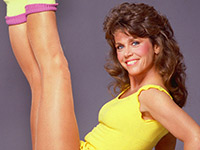Staying Fit
The truth is that we started out so strong. Flipping a Frisbee, pumping iron or feeling the burn, most of the 76 million boomers were poster children for health and fitness. Physical perfection was possible — what else could explain a single generation producing Bo Derek and Brad Pitt?
"Baby boomers led an unprecedented fitness revolution, into a kind of golden era of health," says Kenneth H. Cooper, M.D., whose 1968 best-selling Aerobics put modern exercise on the map. In 1968, less than 24 percent of American adults exercised regularly; by 1984, that figure had risen to 59 percent. Cholesterol levels fell, and so did blood pressure. Deaths from heart disease plummeted 48 percent. And, in large part due to boomer mojo, the average life expectancy jumped from 69.7 years for those born in 1960 to 75.4 for those born in 1990, a huge gain.


AARP Membership— $12 for your first year when you sign up for Automatic Renewal
Get instant access to members-only products and hundreds of discounts, a free second membership, and a subscription to AARP the Magazine.
What made our sweat special? It's not just that we wanted tight tushes, better health and eternal youth. (Of course, we did, but that's been true since before Spartacus rocked his squats and lunges.) It's that we fashioned fitness into a personal statement. "Our workouts became a sort of self-expression and a badge of honor," says Kathy Smith, 62, the fitness instructor whose best-selling workouts spanned disco-inspired dance to cardio-intense boot camps.
Boomer Fitness 1953-2013
This interactive timeline features boomers that helped lead "the golden era of health."


In fact, though, the early pressure on boomers to exercise didn't have any feel-good roots — it was caused by angst over the decreasing fitness of our nation's children. When 1950s research from New York University showed American youths were significantly less fit than their European counterparts, the feds sprang into action, notes Ed Thomas, a fitness historian and former instructor at the U.S. Army Physical Fitness School. President Dwight Eisenhower fretted. John F. Kennedy wrote a cover story for Sports Illustrated called "The Soft American." By 1966, Lyndon Johnson had established the first Presidential Physical Fitness Awards, all in the name of national fitness.
The boomer generation took that patriotic fervor a bit further, making exercise not just fun, but also an expression of pop culture. Gidget, Moondoggie and the Beach Boys popularized surfing. Gold's Gym opened in California in 1965, and Muscle Beach became the stomping ground for the famously buff, most notably Arnold Schwarzenegger. Running became the new religion, propelled by Frank Shorter's 1972 Olympic gold medal for the marathon. In 1968, America had 100,000 joggers. Just 10 years later, there were 27 million.
Befitting a generation in its reproductive years, exercise turned into a social scene. While there had long been sport-specific gyms, such as racquet clubs or pools, the 1970s gave us all-inclusive "health clubs," where guys and gals could meet attractive hard bodies — plus down a smoothie and get their glow on. Fitness's influence galloped into fashion, with leotards and Lycra moving from the gym to Studio 54's dance floor. (Remember leg warmers?)

































































More on Health
You Call This Retirement?
As the idea of the American retiree evolves, don't expect to see so many boomers on the golf course